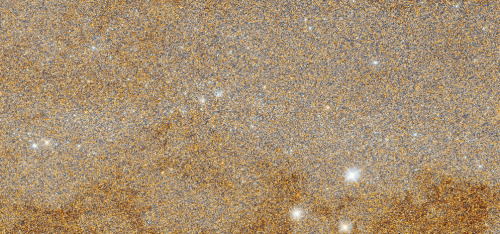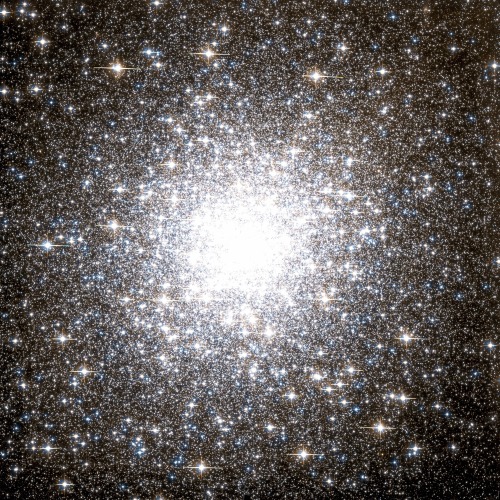M8 // Lagoon Nebula (left Of Center) & M20 // The Trifid (bottom)

M8 // Lagoon Nebula (left of center) & M20 // The Trifid (bottom)
More Posts from Littlecadet-biguniverse and Others

Emission Nebula Sh2-72
js

Milky Way js

A shot of just a tiny bit of the Andromeda Galaxy, from the sharpest ever view taken by the Hubble Space Telescope
Full size image
(NASA)
The Juno spacecraft just recorded these creepy sounds around Jupiter
Via Science Alert


150,000 Stars - The Messier 2 Star Cluster
This massive Star Cluster (The Messier 2 Star Cluster) is 13 billion years old - making it one of the oldest star clusters in the Milky Way Galaxy. Not only is this Star Cluster ancient, it is one of the largest known star clusters. On a clear night away from light pollution, you can see M2 with the naked eye as a faint blur in the constellation Aquarius.
Credit: NASA/Hubble/SIMBAD Astronomy db

Our Moon along with Jupiter and it’s 4 largest moons.
Image Credit & Copyright: Cristian Fattinnanzi
Do telescopes actually take colorful photographs or are the pretty colorful photographs of galaxies that we know colored afterwards? If a human was floating through space, would space look colorful to them?
So some pictures are taken in different wavelengths to see different characteristics. (infrared wavelengths to see through thick gas and dust, xray wavelengths to see highly energized regions)
But, in the visible wavelengths you are seeing the colors. They’re just enhanced brighter than they might be.
For example, I took this picture of “the California Nebula” using a camera (Canon 60Da) attached to a telescope. This shows one exposure, and the background is red due to effects of the camera (which you subtract):

You take multiple exposures, combine them, subtract the background effects & adjust the color a little and get this…


Crescent Nebula

Carina Nebula clouds. So stunning.

-
 donutsandpancakes liked this · 9 months ago
donutsandpancakes liked this · 9 months ago -
 tiffanylunarar liked this · 2 years ago
tiffanylunarar liked this · 2 years ago -
 byrafayozef liked this · 3 years ago
byrafayozef liked this · 3 years ago -
 tnwhmscl reblogged this · 3 years ago
tnwhmscl reblogged this · 3 years ago -
 xristinamp liked this · 3 years ago
xristinamp liked this · 3 years ago -
 kohakunushii reblogged this · 3 years ago
kohakunushii reblogged this · 3 years ago -
 kohakunushii liked this · 3 years ago
kohakunushii liked this · 3 years ago -
 phobic-human liked this · 3 years ago
phobic-human liked this · 3 years ago -
 uferpwn liked this · 3 years ago
uferpwn liked this · 3 years ago -
 astronauths reblogged this · 3 years ago
astronauths reblogged this · 3 years ago -
 astronauths liked this · 3 years ago
astronauths liked this · 3 years ago -
 rickzaiah liked this · 3 years ago
rickzaiah liked this · 3 years ago -
 ekax reblogged this · 3 years ago
ekax reblogged this · 3 years ago -
 crazyfayeplummerart liked this · 4 years ago
crazyfayeplummerart liked this · 4 years ago -
 imaginos666 reblogged this · 4 years ago
imaginos666 reblogged this · 4 years ago -
 zenpunk-94 reblogged this · 4 years ago
zenpunk-94 reblogged this · 4 years ago -
 thesestrxxts reblogged this · 4 years ago
thesestrxxts reblogged this · 4 years ago -
 lampycancy liked this · 4 years ago
lampycancy liked this · 4 years ago -
 zenpunk-94 reblogged this · 4 years ago
zenpunk-94 reblogged this · 4 years ago -
 zenpunk-94 liked this · 4 years ago
zenpunk-94 liked this · 4 years ago -
 smookahlicious reblogged this · 4 years ago
smookahlicious reblogged this · 4 years ago -
 smookahlicious liked this · 4 years ago
smookahlicious liked this · 4 years ago -
 mysticbluelight liked this · 5 years ago
mysticbluelight liked this · 5 years ago -
 automaticdestinytrash reblogged this · 5 years ago
automaticdestinytrash reblogged this · 5 years ago -
 mellowunknowninternet liked this · 5 years ago
mellowunknowninternet liked this · 5 years ago -
 templs-blog liked this · 5 years ago
templs-blog liked this · 5 years ago -
 automaticdestinytrash reblogged this · 5 years ago
automaticdestinytrash reblogged this · 5 years ago -
 automaticdestinytrash reblogged this · 5 years ago
automaticdestinytrash reblogged this · 5 years ago -
 ugw-98 liked this · 5 years ago
ugw-98 liked this · 5 years ago -
 snailswithwings liked this · 5 years ago
snailswithwings liked this · 5 years ago -
 blackbellatrixx reblogged this · 5 years ago
blackbellatrixx reblogged this · 5 years ago -
 polars reblogged this · 5 years ago
polars reblogged this · 5 years ago -
 capybaragay101 liked this · 6 years ago
capybaragay101 liked this · 6 years ago -
 glitteringstardust reblogged this · 6 years ago
glitteringstardust reblogged this · 6 years ago -
 laetitiaportalchupinsworld liked this · 6 years ago
laetitiaportalchupinsworld liked this · 6 years ago -
 ard-it reblogged this · 6 years ago
ard-it reblogged this · 6 years ago -
 swords0827 liked this · 6 years ago
swords0827 liked this · 6 years ago -
 chopped-peace-collection liked this · 6 years ago
chopped-peace-collection liked this · 6 years ago -
 dreamchasing reblogged this · 6 years ago
dreamchasing reblogged this · 6 years ago
GREETINGS FROM EARTH! Welcome to my space blog! Let's explore the stars together!!!
144 posts